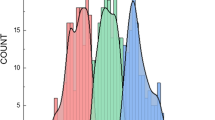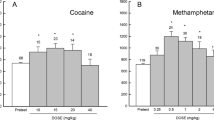Abstract
Place preferences induced by the indirect dopamine (DA) receptor agonists amphetamine (AMP) and methylphenidate (MPD) were investigated using an unbiased compartment procedure. In this procedure, prior to drug conditioning, rats did not exhibit preferences for either of the two compartments in a shuttle box. Both stimulants produced place preferences. Repeated testing of the MPD conditioned animals revealed an extinction-like decrease in preferences, suggesting that place preferences produced by MPD result from conditioning of MPD's reinforcing properties to environmental cues. During conditioning, the DA receptor antagonist haloperidol was administered prior to drug (S+) treatments, or prior to both drug and vehicle (S−) treatments. Haloperidol pretreatment blocked place preferences induced by AMP but not by MPD. In contrast, haloperidol blocked locomotor activity stimulated by either AMP or MPD. These results suggest that the reinforcing properties of MPD and AMP may be mediated by different mechanisms, while the locomotor stimulant effects of the two drugs have common neural substrates.
Similar content being viewed by others
References
Beninger RJ, Hahn BL (1983) Pimozide blocks establishment but not expression of amphetamine-produced environment-specific conditioning. Science 220:1304–1306
Bozarth MA, Wise RA (1981) Heroin reward is dependent on a dopaminergic substrate. Life Sci 29:1881–1886
Di Scala G, Martin-Iverson MT, Phillips AG, Fibiger HC (1985) The effects of progabide (SL 76002) on locomotor activity and conditioned place preference induced by d-amphetamine. Eur J Pharmacol 107:271–274
Katz RJ, Gormezano G (1979) A rapid and inexpensive technique for assessing the reinforcing effects of opiate drugs. Pharmacol Biochem Behav 11:231–234
Martin-Iverson MT, Ortmann F, Fibiger HC (1985) Place preference conditioning with methylphenidate and nomifensine. Brain Res 332:59–67
Martin-Iverson MT, Radke JM, Vincent SR (1986) The effects of cysteamine on dopamine-mediated behaviours: evidence for dopamine-somatostatin interactions in the striatum. Pharmacol Biochem Behav 24:1707–1714
Moore KE, Chieuh CC, Zelds G (1977) Release of neurotransmitters in vivo by amphetamine, methylphenidate and cocaine. In: Ellinwood EH Jr., Kilbey MM (eds) Cocaine and other stimulants: Advances in behavioral biology, vol 21. Plenum Press New York, pp 143–160
Phillips AG, LePiane FG (1980) Reinforcing effects of morphine microinjection into the ventral tegmental area. Pharmacol Biochem Behav 12:965–968
Phillips AG, LePiane FG (1982) Reward produced by microinjection of (d-ala), Met-enkephalinamide into the ventral tegmental area. Behav Brain Res 5:225–229
Schwartz AS, Marchok PL (1974) Depression of morphine-seeking behavior by dopamine inhibition. Nature 248:257–258
Sherman JE, Roberts T, Roskam SE, Holman EW (1980) Temporal properties of the rewarding and aversive effects of amphetamine in rats. Pharmacol Biochem Behav 13:597–599
Shore PA (1976) Actions of amfonelic acid and other non-amphetamine stimulants on the dopamine neuron. J Pharm Pharmacol 28:855–857
Spyraki C, Fibiger HC, Phillips AG (1982a) Cocaine-induced place preference conditioning: lack of effects of neuroleptics and 6-hydroxydopamine lesions. Brain Res 253:195–203
Spyraki C, Fibiger HC, Phillips AG (1982b) Dopaminergic substrates of amphetamine-induced place preference conditioning. Brain Res 253:185–193
Spyraki C, Fibiger HC, Phillips AG (1983) Attenuation of heroin reward in rats by disruption of the mesolimbic dopamine system. Psychopharmacology 79:278–283
Stapleton MJ, Lind MD, Merriman VJ, Bozarth MA, Reid LF (1979) Affective consequences and subsequent effects on morphine administration of d-ala2-methionine enkephaline. Physiol Psychol 7:146–152
Swerdlow NR, Koob GF (1984) Restrained rats learn amphetamine-conditioned locomotion, but not place preference. Psychopharmacology 84:163–166
Waldmeier PC (1982) Effects of antidepressant drugs on dopamine uptake and metabolism. J Pharm Pharmacol 34:391–394
Author information
Authors and Affiliations
Rights and permissions
About this article
Cite this article
Mithani, S., Martin-Iverson, M.T., Phillips, A.G. et al. The effects of haloperidol on amphetamine-and methylphenidate-induced conditioned place preferences and locomotor activity. Psychopharmacology 90, 247–252 (1986). https://doi.org/10.1007/BF00181251
Received:
Revised:
Issue Date:
DOI: https://doi.org/10.1007/BF00181251




